Equilibrism: Dimensions of the Functioning of the World
February 9, 2023
One of the distinguishing features of our times is the increasing polarisation of opinion in society. Some groups of people seem to be less and less able to communicate with each other. This is clearly visible in the important social issues we have been confronted with in recent years. Whether it is covid, the Russian invasion of Ukraine or other global issues, the social debate is quite heated. Of course, this does not apply only to recently raised issues, but also to established ones such as abortion, religious freedom, vaccination in general, the right to privacy, censorship, etc.
To a large extent, this state of affairs is the result of human progress and, above all, technology, exemplified by the media and social networks. Most specifically, we can identify algorithms as the imaginary tip of this apparatus. This is not to say that polarisation and the splitting of opinion did not exist before the advent of mass media and social networks, but these greatly reinforce and accelerate polarisation. The impact of technology on opinion genesis is at least threefold, and researchers have been looking at each of these individually for some time.
First, the influence of algorithms on the so-called hermeneutic circle. Algorithms present to the user primarily what they are interested in and agree with. Their views are thus repeatedly confirmed, and they become increasingly enclosed in a bubble, unwilling to accept anything contrary. This is also not news, but algorithms again only reinforce this effect. The second effect is the information overload in which we live. The advanced possibilities of communication and mass communication constantly present us with incredible amounts of data. It is difficult for many people to navigate such a mass and to be able to take in information that is both true and valuable. The third impact is the exponential acceleration that is brought about with this progress at once. This effect is the de facto cause of the first two. It is precisely this acceleration component that makes the processes in society, which would have previously taken some time, increasingly shorter.
But technology and media are only one of the causes of the current state of affairs, and the current state of affairs is only one aspect of what I want to write about. What I am going to focus on in this article is an absolutely universal way of thinking and approach that is applicable to all phenomena around us, not just in the present time. It is a timeless tool of thinking that can help to properly understand and respond to the workings of the world. The introduction of this text, dedicated to the current state of polarization of society, serves only as a first example on which I will be able to show the application of this universal tool. At the same time, this condition has also catalyzed and accelerated my thinking, which I will defend here, so that I have been able to elaborate it into its present form, although it has been formulating itself within me in its basic essence for a long time.
Yet polarisation is one of the most important contemporary issues because its impact is real, and the potential risks are high. Although the mode of polarisation is specific to particular local political and social situations, it bears a number of common features in this globalised world across countries and even continents. I will give examples mainly from the Czech and American settings, but similar principles apply in many democratic countries. Traditionally, for example, the most obvious form of polarisation in contemporary society could be characterised as a division between conservative and liberal thinkers. We would certainly find signs pointing to this dividing line in both the Czech Republic and the USA. We could also consider the division between right-wing and left-wing minded people, or similar traditional polarising trends. In reality, however, the current polarisation is moving in a different direction, which I will explain in the course of my reflections. Another phenomenon that is related to both polarisation and technology is misinformation. In the Czech environment, the argument that "the truth is somewhere in the middle" is often voiced by those who are associated with disinformation. The problem is that the intention of this argument is to relativise something that is quite clear. Because of this unambiguity, the generally accepted paradigm already favours one side. In trying to challenge this paradigm, any shift away from truth achieves this purpose, even if it sounds rather generous - "truth in the middle". But a half-truth is often as damaging as a lie. Yet these people do not realize how crucial the idea of "truth in the middle" is. But we need to understand it in the right context.
Without wishing to dwell extensively on the question of whether truth exists and what is true, I will work with the concept of truth idealistically. It is clear now more than ever how important and non-relativistic the notion of truth is. On the issue of the war in Ukraine or the "(un)stolen" US presidential election, the need to get to the bottom of how things really are is socially fatal. Otherwise, society is necessarily faced with the aforementioned high risks and even damages that are already largely evident. There is the collapse, or at least the crisis, of democracy, the associated loss of freedom and, in the case of the war in Ukraine, the loss of life. In both of these cases, things have happened and are happening in a certain way. If a dispute is being fought at the most fundamental level, it is impossible for both sides to be right, even though the circumstances may be complex. And it is the complexity of some topics and issues that often forces us to recognize that "the truth is somewhere in the middle."
If we acknowledge that the truth is somewhere in the middle, while understanding that this phrase cannot be applied always and in all situations, it is clear that we must be operating on two separate but related planes. Or rather, on one plane, or reality, but on two axes. Specifically, this concept can be fully outlined on the Cartesian coordinate system. In all existence there are two groups of principles - horizontal principles and vertical principles. The horizontal principles are equal to each other, standing side by side, and one is not superior to the other. The vertical principles are just the opposite, they are stratified, and some are above others and superior to those below them. In other words, within the horizontal principles it is impossible to say which ones are better and which ones are best, because there are none. They are all equal. Within the vertical principles, it is always possible to label each one better than another until we reach a peak of the imaginary stratification where lies the best. In both sets, the principles occur in complementary opposites and on scales. I use the word scale because these are not only binary principles of Boolean algebra, but also simply opposing principles. Thus, in simplified terms, it is not always 1, or 0, but at times also 1.0; 0.99; 0.98; ... -0.98; -0.99; -1.0. But not in a discrete form, which I have just used as a mere illustration, but in a continuous form. On the vertical axis this is exclusively the case, on the horizontal axis predominantly. I will call this type of principles the oppositional type and it will be the key type for my thinking. A less common type is the paradigmatic type, which is found only on the horizontal axis and in which the principles are not oppositional and scalar, there is no tension between them, but their order or distribution is interchangeable.

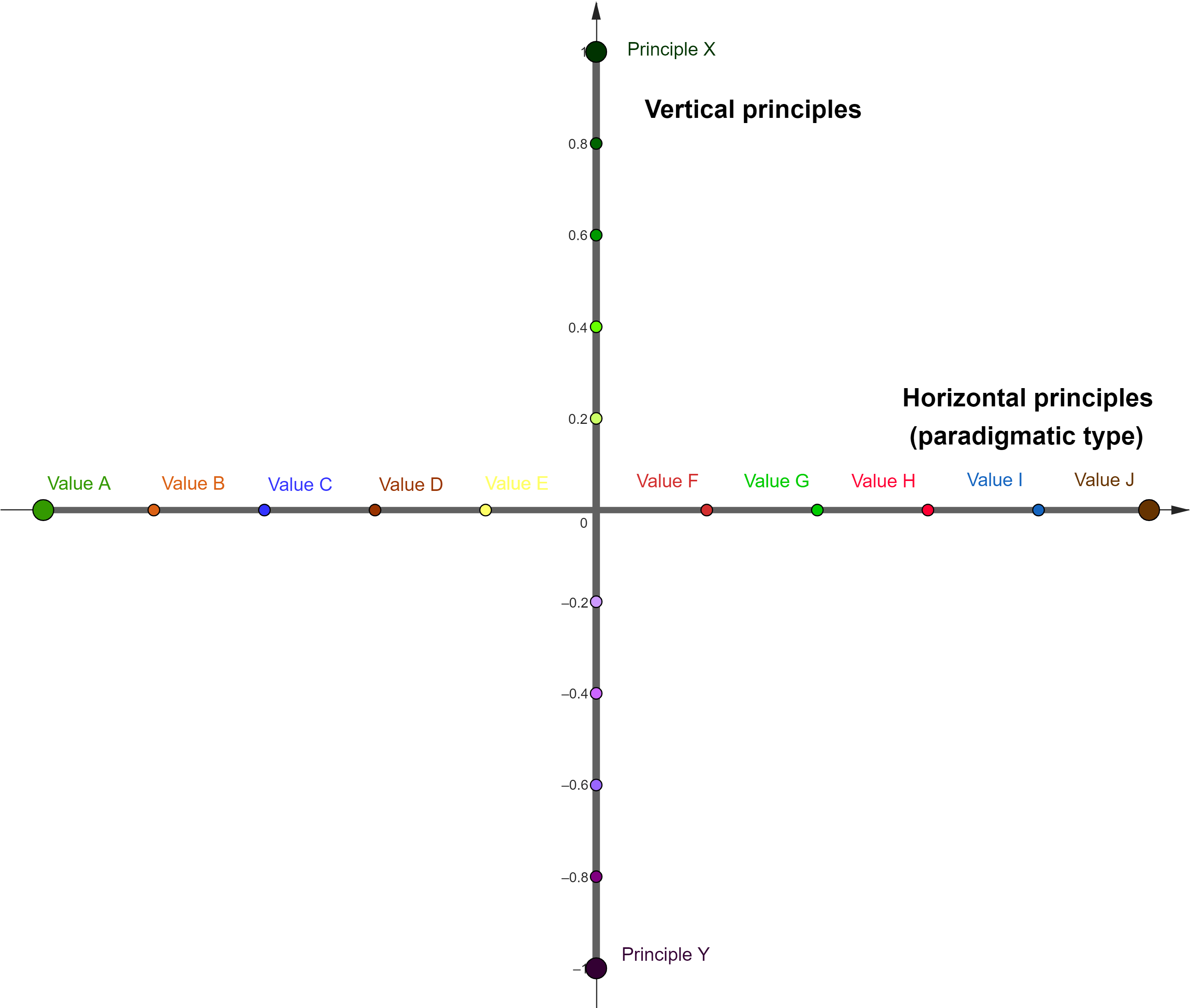
When I say that on the vertical axis of principles in our Cartesian coordinate system, what is above is better than what lies below, this can be taken literally. One of the basic sets of principles that lies on the vertical axis is good and evil. Good is at the top of the axis, evil at the bottom. Good is better than evil; at the same time, they are opposites and a certain scale, so it is an oppositional type of set of principles. They are mutually exclusive; one is on the opposite side of the other. The vertical axis is characterized by unambiguity - the top of the scale is categorically better than the bottom of the scale. This applies to all the principles that lie on it. These include, in addition to good and evil, a number of principles that we often associate with morality. These are opposites such as truth and falsehood, peace and violence, wisdom and stupidity, knowledge and ignorance, love and hate, freedom and captivity, respect and disrespect, humility and arrogance, fulfillment and disappointment, joy and unhappiness, stability and decline, order and chaos, etc. These oppositions are not something linguistically conditioned in the structuralist sense, they are independent of language and even independent of people, or rather superior to people, because they exist and are valid even when people cannot name them, either ontogenetically, that is, because they have not been personally acquainted with them, or phylogenetically, that is, because they have not been acquainted with them as a nation, society or community. But these principles are intimately connected with us, and language is a tool for our understanding of these oppositions and principles.
The sets of principles on the horizontal axis are slightly more complex. They can include principles from many different areas - political, social, economic, artistic, scientific, and just about any area that we can think. Very often these principles are also in scalar relations, i.e., in the oppositional type. Examples of these are the political mindsets of left-wing and right-wing, conservatism and liberalism, and so on. Or more general principles such as concreteness and abstractness, whole and detail, ratio and emotio, analysis and synthesis, public and private, structure and contingency, subjectivity and objectivity, centripetality and centrifugality, culture and nature. But also the physical concepts of waves and particles or the metaphysical concepts of spirit and body. And furthermore, content and form, potential and actual, matter and energy. And if the sets of some of these pairs seemingly contradict each other, their superordinate principles (which themselves combine these pairs into a single notion) are also found on the horizontal scale - for example, hylomorphism and mechanical atomism. These are all oppositional types of sets of principles. At this point you could accuse me of dualism, and that is fine. Indeed, a large part of the principles of our being are found in oppositional scales. But unlike traditional dualism, it is the dualism on the two axes that I just described, and the relationship of those two axes, that is important. And this is where I depart from traditional dualism. I do not see the opposites on the horizontal axis as mutually exclusive or competing. Or at least not in their ideal state. Opposing principles are not disjunctive, but conjunctive. Even if they are opposite and there is tension between them, that does not mean they cannot coexist. On the contrary, it is only in their exact balance and simultaneity, in the application of both of them, that we move up the vertical axis, that is, toward what is good, functional, true, and stable. At this point it would seem that this is a classical dialectical approach. This is also partly true, but not in the sense of a classical conflict from which another, better form of functioning, being or category emerges. Rather, it is a joint synthesis, not a contradiction, although I acknowledge its role, as well as that of discussion and confrontation. I do not, however, recognize violent encounter, because violence itself, in most of the cases, pulls the outcome of the encounter down the vertical axis, not up. And this is another difference from classical dialectics - I do not emphasize only the forward (upward) movement, but it is important to perceive the entire length of the vertical axis, which runs on the Cartesian coordinate from the horizontal axis both up and down. This whole functioning and dynamic are what I call equilibrism. This is because only the proper balance, combination, utilization of both, and center (not conflict) between the two horizontal principles of the oppositional type leads to the positive results described, moving us upward on the vertical axis.
A concrete example that can be given is politics. For example, the aforementioned right-wing and left-wing mindsets are an oppositional set of principles on the horizontal axis. For the proper functioning of the state, we need both in the right balance. Without wanting to go deeply into a political science discussion, I will only suggest something probably obvious. We need both the right-wing that allows the economy to function properly and healthily, generating higher economic turnover and thus contributing to our well-being, just as we need the left-wing that distributes that well-being, allows society to take care of those who cannot make it on their own, gives us security, and ensures the proper and healthy functioning of society. Without the politics of the right, we could not afford the politics of the left, and without the politics of the left, society would not be in a state where the politics of the right would do it much good. Everyone needs external support but at the same time internal accountability. Each to a very different degree, but both nonetheless. So we need a capitalist-social pluralist democratic society, filled with free options, but also with regulation and appropriate redistribution. The closest approximation to this ideal at present are some central, western and northern European countries, which are considered the best countries in the world to live in as a result. But each of them has its own problems that are not reflected in this simple equation, just as there are many other countries with advantages that are not reflected here either. Even right-wing and left-wing politics have many more functions, of course, but I give this as one example. However, it is only by balancing them and applying them simultaneously that we achieve the desired result. There are, of course, people who are on one side or the other of this oppositional scale, who consider their positions to be superior to those of the other side, and who promote only left-wing or right-wing principles and despise the other. This comes from a misunderstanding of political functioning, not from a misunderstanding of equilibrism. However, understanding equilibrism can help one understand the proper functioning of politics and everything else. This example is not to say that we do not need people and institutions defending right-wing and left-wing principles. We need them, we absolutely need both, and we need them in a balanced way, as well as their application. It does not make sense to fight for the victory of one party; it only makes sense to fight for the victory of a flourishing and successful society, that is, to move upwards on the vertical axis, which is only possible by balancing on the horizontal axis. So we need people and institutions defending right-wing and left-wing principles for the functioning of society as a whole. But each individual one of them should understand the need for the opposite side of the horizontal axis. As a result, we sometimes need to advocate right-wing principles, and sometimes left-wing principles, in an attempt to achieve balance. This functioning is seen in practice in society, where the mood of society spills over from one side to the other, often from election to election. This is made possible by political pluralism, which is a manifestation of the more classical notion of dialectics and a successor to the classical notion of the dualism of religious and state power. As such, I see political pluralism as an environment that allows for the operation of equilibrism. In its own terms, then, pluralism is on the top of the vertical axis. It may seem out of place for me to talk about pluralism when I always mention dualistic pairings. But pluralism is based in the fact that there are many of these horizontal dualities and oppositions. It is good that society as a whole has this equilibristic self-regulating capacity, but it is limited, and its meaning is misunderstood by many people, so it does not work completely reliably. Equally misunderstood is that this functioning is only one particular example of equilibrism.
I have briefly explained how balance on the horizontal axis in this particular aspect of politics leads to progression on the vertical axis. But do the principles that are part of politics also lie on the vertical axis without being a consequence of what happens on the horizontal axis? An example of such principles might be the oppositional scale of truthfulness and lying. Politicians can tell the truth, or they can lie. And this already allows us to distinguish between a bad politician and a good politician. We can therefore say that if there are only these two dimensions of politics - the right-left spectrum and truthfulness - a good politician is one who tells the truth, whether they stand for left-wing or right-wing principles, and a bad politician is one who lies, whether they stand for left-wing or right-wing principles. It is good for society if there are two politicians - one truthful right-wing and one truthful left-wing. Any other combination drags society down the vertical axis. Let me remind, that this assumes that there are only these two aspects of politics. However, another vertical dimension of politics can also be the aforementioned democratic pluralism and its opposite authoritarianism, or populism leading to authoritarianism. Another horizontal dimension of politics may be conservatism and liberalism, which are, for instance, in the United States associated with the set of right-wing and left-wing principles, but it does not have to be that way. It may seem that one horizontal side - liberalism - tends vertically upwards - towards democratic pluralism - while the other - conservatism - tends vertically downwards - towards autocracy. But this is the undesirable one-sided view, which is false. And some people will view these tendencies in exactly the opposite way. Because liberalism can also seem to tend downwards to anarchy and conservativism can seem to tend upwards to stability. But the key element of the movement on the vertical axis is something quite different - it is balance in the middle; adherence to principles that are vertically above; and avoiding extremism on either side of the horizontal axis. It is indeed extremism and lack of balance that tips over either horizontal side towards its vertically inferior potential. In case extremism is not avoided, both sides will end up exactly the same and shake hands at the bottom of the vertical axis, as did Joachim von Ribbentrop and Vyacheslav Molotov, representatives of seemingly opposite political systems. Both sides on their own are gravitating downwards, gravitating towards extremism, towards degradation and destruction. That is why they need each other to balance each other out. Only in this way can they both head upwards and together establish a functional existence. As with the right-wing and the left-wing politics, we need conservatism and liberalism. Liberalism so that society can find new ways and new solutions, and conservatism so that we are able to use and implement them properly.
It might seem that I am trying to present populist centric views, that are ambivalent and non-offensive. This could not be further from the truth. I am not presenting anything non-specific and non-opinionated so as to reach the largest possible audience. On the contrary, I present everything at once, except extremism, because on the horizontal axis, everything at once, in its balance, is the best solution to everything. That is why this philosophy is likely to be unpopular with people who gravitate in one direction or the other. But all those who desire to know the truth, and knowledge of things as they are, must agree with me. The burning problem of today's society is that the horizontal and vertical axes are being confused. People do not distinguish between them. In the explanation of this distinction and relationship is the main contribution of equilibrism. The fact that people do not distinguish between these axes and types of principles is manifested precisely by the fact that we hear that right-wing politics is evil or that left-wing politics is evil. That is not true. Their proponents can be evil because they do not adhere to the principles on the vertical high, including not giving room for the balancing of the two mindsets, even when it would be needed in the given country. That is why it may seem that in that country either the right or the left is wrong. But it is not the principles that are bad; it is the lying and populism that is bad. The current state of affairs is thus a manifestation of confusion between the two axes and types of principles. In many countries, including the Czech Republic, elections are no longer held in which voters are choosing between right-wing and left-wing politics, or conservative and liberal politics, as they should be, in order to rebalance the political system and move it upwards. But the two sides of these horizontal principles are scattered into new opposites that are on the vertical axis. The new choices for citizens are therefore truth or falsehood; freedom or subjugation; true democracy or populism. This is the crisis of contemporary democracy. It is no longer a pluralist choice of horizontal principles, but a choice of democracy itself, or its opposite. This is not to say that those who constitute the first choice, the democratic choice, represent the vertical apex, that is, absolute truthfulness and honesty. By no means. But the difference from their alternative is considerable. The situation is different in the United States in that the horizontal political principles are not scattered into both alternatives. There they remain fairly concentrated, each on one side - Republican or Democratic. The problem is that, under the influence of Donald Trump, the Republican Party has begun to descend vertically downwards in a very serious way, while the Democrats are also descending vertically down under the influence from radical leftist politics, that divorces democratic principles. So, for the American people, the choice is now different - both right-wing and left-wing descend vertically down, not in all aspects, but in some important ones. Therefore, even Americans do not now have a true choice of two vertically high-quality parties.


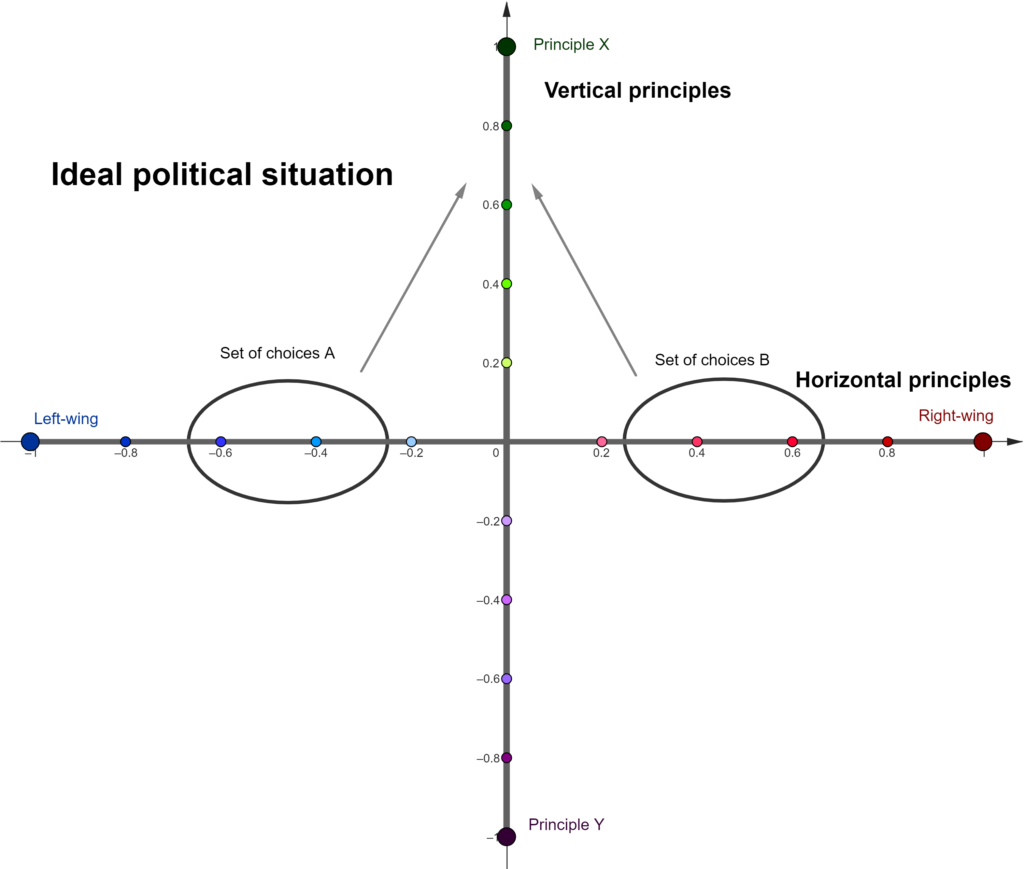
The same problem is found on a global scale in the duality of the political West and East, which could be an oppositional set of principles on the horizontal axis, but it is not so and never was in the 20th century. At least not in its full form. And while these two poles did and do offer some alternative, we cannot say that they are vertically aligned and therefore cannot be used for balancing and vertical ascension. The West has partly had to take on this whole task and, precisely because of its integrated pluralism, offer horizontal alternatives, albeit limited ones. For the East has always come out of the comparison as the vertically inferior one, because it tends more towards falsehood, totalitarianism, restrictions on freedom and rights. This global non-ideal functioning feeds back into the internal workings of the local dimensions, and the above-described split in the political scene is further polarized by association with a world state that pulls one side vertically down and leaves the other without an adequate horizontal opponent and alternative.
With this we can move on to media, but we will stay with the topic of politics. There is an organisation called Ad Fontes Media which is working on a project called the Media Bias Chart®. It is a figurative map on which the organization places news media, primarily the American media. The map is organized on two axes - the horizontal axis represents, same as in this essay and my philosophy, the political spectrum of the right-left. The vertical axis represents media credibility. The media is placed on the map according to which political side they are biased towards and how credible they are. And as you might guess in the context of this text, if we look at the findings of Ad Fontes Media, we find that the further a media outlet moves along the horizontal axis to either side from the center, the less credible it is - the further it deviates from the truth. The graph of this distribution is so symmetrical and descending from the center that it literally forms a pyramid. This means not only that neutral media are the most truthful, but also that the most truthful media are those that are balanced (the horizontal axis captures bias, not neutrality) and that avoid extremes and extremism. People who follow and trust media that are further horizontally from the vertical axis are the ones most affected by polarisation and are furthest from the truth, often even inclined to believe misinformation. This brings us back to our initial thesis on the role of the media. These information media are linked to social networks and thus, with the reinforcement of network algorithms, are part of the hermeneutic of affirmation.
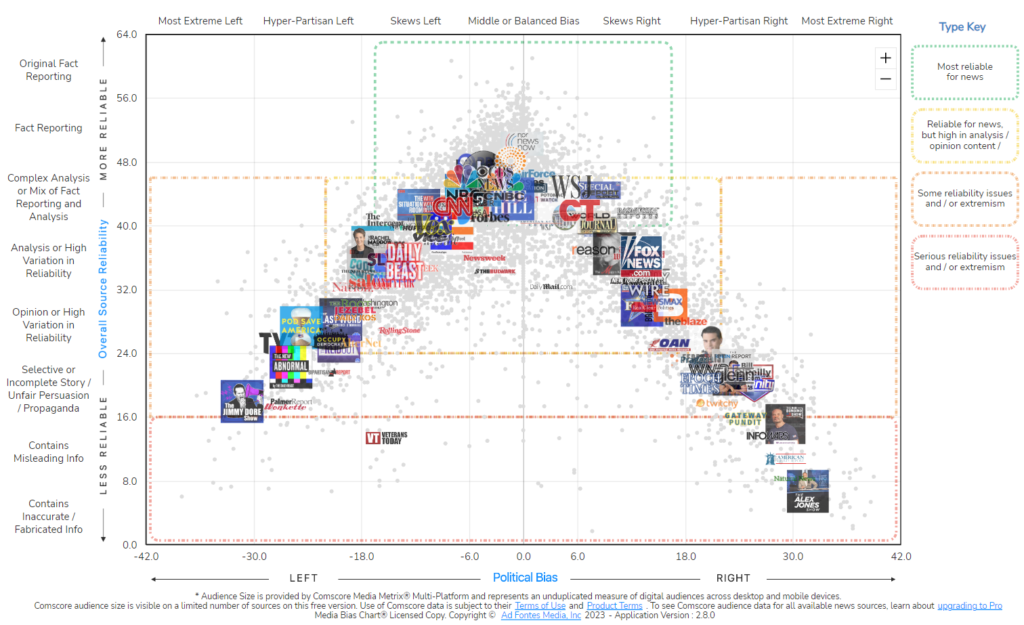
The contradictory nature of the opposition on the horizontal axis is not bad in itself, on the contrary, as I have already described, it is a good phenomenon, but only in balance and harmony. It becomes bad the moment one side fails to recognise the other or when any side degenerates into extremism, i.e. starts to fall down the vertical axis. This can happen by spiraling in a hermeneutical circle towards either horizontal side. The opposite phenomenon is an upward spiral through equilibrism, i.e., balancing. Extremism is wrong in any respect unless it is upward extremism on the vertical axis, but the term extremism is not usually used in connection with principles on that axis. Therefore extremism always pulls downwards. The English idiom "everything in moderation" tries to express a similar idea, but in a popular application. Nothing must be extreme, except the pursuit of balance, goodness and truth. Otherwise, extremism is precisely what brings destruction, ruin, and chaos, and also what ultimately shakes hands at the bottom of the Cartesian coordinate system, whichever side it takes to get there. The state of society today begs the question of to what extent and in what areas it makes sense to unify society. Equilibrism is the answer. It makes sense to unify society on the basis of vertical principles. On the basis of horizontal principles it is only worthwhile to the extent that people learn to respect the other side of the scale and demand equilibrism. While all people will certainly not achieve their own and inner equilibrism, by understanding and applying this principle we can achieve equilibrism at least on the level of society as a whole, and through that live in stability and grow toward truth and goodness.
One of the essential characteristics of equilibrism is growth. Upward growth along the vertical axis, which I have already indicated several times by words like movement or heading upwards. Not only growth up the vertical axis, but growth itself is at the top of the vertical axis. We need not call it growth; we can also speak of progression or advancement. It is essentially that upward spiral I wrote about above. If we decompose this spiral in time, not just space, we get a sinusoid. For growth requires time, and time is one of the dimensions of growth. The sinusoid expresses the oscillation from side to side, but it also expresses progress. The duality of the two poles on the horizontal axis provides a kind of energy and momentum on the basis of which the whole can move forward. This operation is also rooted in the operation of physical laws such as electromagnetic induction. The synergistic tension of two balanced poles results in forward motion. Generally, this functions because there is an oscillation on the oppositional horizontal scale, and due to this there is movement. This is to be seen precisely in that left-right self-regulatory capacity of society. This does not necessarily mean that my view is teleological, although for the most part it is, but in some respects a movement forward is necessary to achieve stability at all, such as when you ride a bicycle. You don't fall off only if you are going forward, and you only go forward if you alternate pedaling with your left and right foot. This is the only way to achieve and maintain balance.
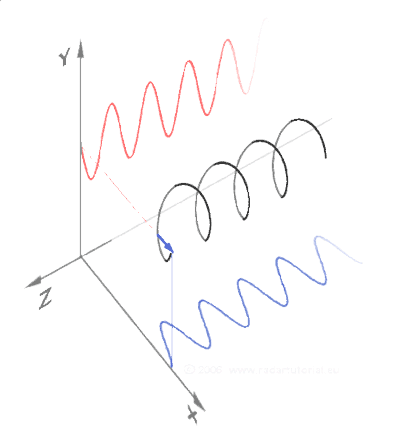
So far, I have only written about clearly distinguishable oppositional scales on the vertical axis, but there are many areas and themes that hide an inherent and intrinsic vertical duality. This is the case, for example, with technology. There are conflicting views on whether technologies are good or bad. But they are neither. Or rather, they are both, depending on what we make of them or what we leave them to do to us. Technologies have a high degree of internal opposition that is dependent on our use of them. Their potential is large on both sides and is vertically symmetrical (i.e. symmetrical along the horizontal axis). Technologies offer great potential for upward and forward movement, but also for decline and misuse. Therefore, technologies catalyse and accelerate. The greater the possibilities on one side, the greater the possibilities on the other side. They catalyze misinformation and polarization, which are present in some form even without them, so they catalyze the downward slide. But they also catalyze unification and balance, for they bring us information, knowledge, and through that, understanding and truth. They bring both at once with greater intensity and speed, and act as a magnifier of our input, desire and search. This is not only how modern technology works, but also, for example, faith as a principle, power, money, artificial intelligence, globalization, etc. All of these hold immense inner potential in both directions on the vertical axis.
Also, so far I have only dealt with the oppositional type and scales of sets of principles because they are the most common and, as I mentioned, exclusive on the vertical axis. An example of the second type, paradigmatic, is the personality of man. These are many possible combinations that are not necessarily opposed to each other, although some of their components may be oppositional. And while the personality of man, as a set of many possibilities, of which it is impossible to say which is better, lays on the horizontal axis, on the vertical axis is the character of man, which in turn is an oppositional type. So there are distinguishable character poles, but because we are on the vertical axis, categorical good and evil are also distinguishable. This does not mean that some people are bad and some people are good. Here scalarity is absolutely the case as opposed to binarity. But we all have character traits that are either good (like truthfulness, honesty, generosity, kindness, etc.) or bad (the opposite of the good ones - deceitfulness, dishonesty, meanness, etc.), and we usually fall somewhere between the poles on the given scales. And while in our imperfect knowledge of others we cannot judge which people are better than others, some people better are. Not by their nature, but because of their character choices. In this respect, man is similar in his dual potential to the areas and functioning described in the previous paragraph. But what does not make a person better or worse is their personality, whatever psychological tools we take to describe it - temperament, Enneagram, MBTI, Big Five, or others. These tools are helpful but limited, and only express a certain part of personality. Another part may simply be taste. In the end, however, we are each unique in our personality and no one personality is better than another. There is nothing better about someone liking the color blue than another liking green. We may personally prefer a certain personality type because it is more compatible with our own, but that does not mean that our preferred personality type is vertically superior. But it is better to be the one who honors others around him than the one who looks down on them. Personality and character. Many of the individual principles that constitute character are, of course, oppositional, not paradigmatic. But still, of course, on the horizontal axis. Examples might be extraversion and introversion, or orderliness and spontaneity.
Combining many different horizontal dualistic sets of principles in a single thematic area to form an illustrative picture of them is possible in a Cartesian coordinate system augmented by a third dimension, namely the spatial dimension, not the temporal dimension as in the spiral to sinusoid decomposition. In three-dimensional space we can then have infinitely many horizontal opposing scales, all of which intersect at any point with coordinates 0; 0 on the horizontal plane of the three-dimensional Cartesian system, in other words the x and y axes. Thus, for each of these scales, the 0; 0 point of the horizontal plane is also its center. Their multi-equilibrium point, or vertical height based on the conjunction of all horizontal opposites, will then lie on the coordinates x = 0; y = 0; z = 1. This is the true plurality I mentioned in connection with political functioning and pluralism. That is also why we cannot operate only in dualistic thinking - each oppositional set of principles tends to be part of a much more complex problem where multiple oppositional sets meet. But they are all in one (horizontal) plane (formed by the x and y axes) and a balance point can be found in the space above them. If we find balance in plurality in one set of principles, we can find it more easily in other sets. The individual horizontal oppositions relate to this point, or close in from the sides, and together the model is again pyramidynamical. In space, however, it forms a cone - the base or any horizontal cross-section thereof is the horizontal principles, and the apex is the point of equilibrium. In the horizontal plane of the plurality of principles in the spatial model, paradigmatic types of sets of principles can lie of course as well. These too will often be mixed with oppositional ones, as I suggested in the context of personality. But even above these, there will be an equilibrium point of vertical height. And as is clear from the previous paragraph on the personality of man and this paragraph on plurality, the complexity of issues is often multi-level and applicable at different scales of the problem. The overarching solutions then form counterpoints on a larger scale and are part of a larger problem or solution. Often, then, spatial plurality would look almost like a limited fractal of cones, with one larger standing on top of smaller ones and those in turn standing on top of even smaller, while all of it being a part of a complex topic. Each of the levels, even the smallest ones, are based on equilibrism, and equilibrium on each level will generate a vertical result suitable for building the next level until we gradually reach the top, which is the main multi-equilibrium point.
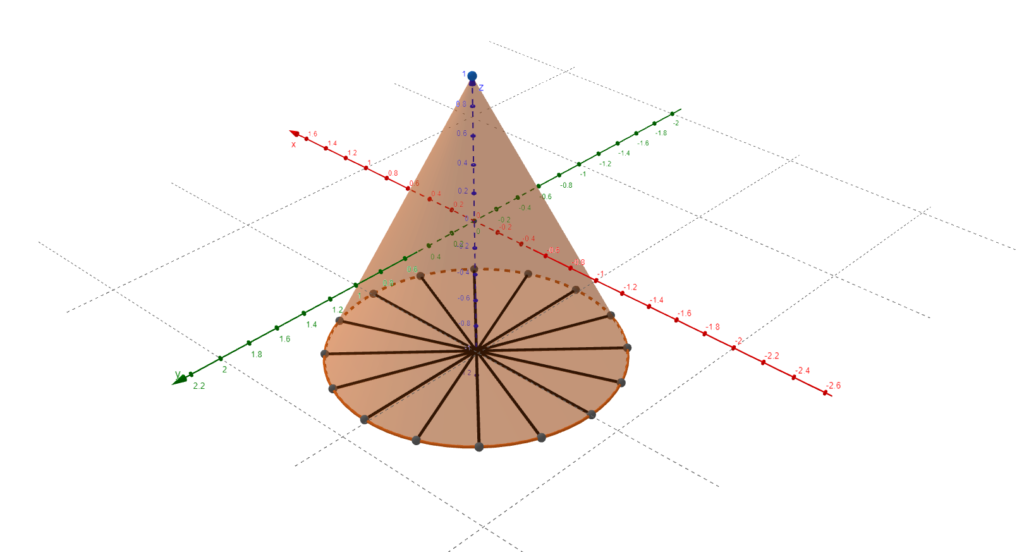

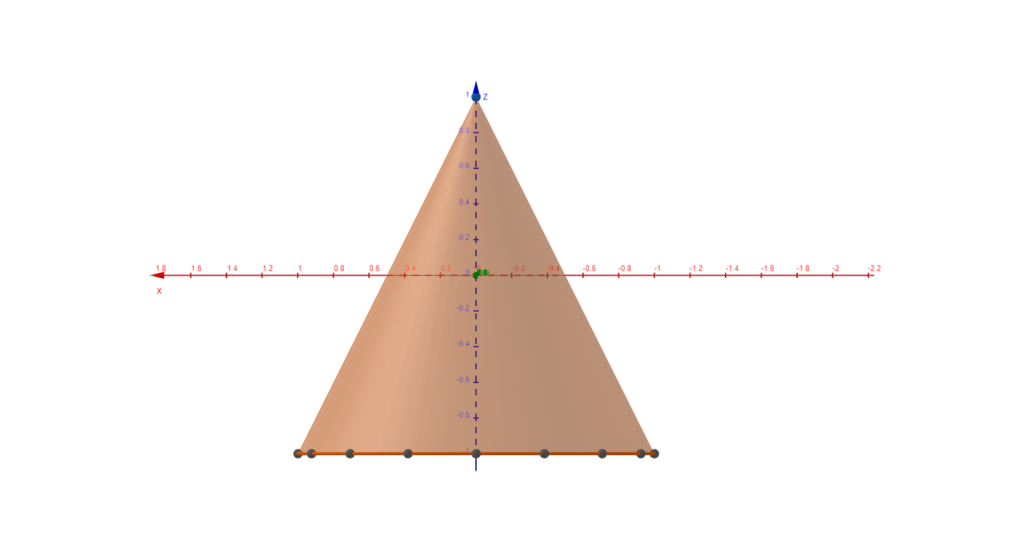

Equilibrism is the dynamics of how the world works and also its ideal state. Everything can be described by it, and it can help us in a fundamental understanding of anything. On the horizontal axis, for example, there is also the oppositional scale of smallness-bigness. It is no coincidence that man is in the middle of this scale, as the best balance of all existence. This is nicely seen in The Scale of the Universe project, which shows that all physical existence ranges from 10-35 m to 1027 m and humans are roughly just in the middle at 100,2 m. One could argue that we will of course see it this way from our anthropocentric perspective. However, if we consider all of the being that is conceivable or perceivable by an organic being, we see that it is arranged around the human midpoint in a pyramidynamical fashion, as we saw on the Media Bias Chart®. For organic existence itself lies fairly in the middle. And if a non-organic body, such as a computer, is capable of thinking something even smaller, it is most likely that it will also be capable of thinking something even larger, and vice versa. Thus, the dimensions of smallness and bigness will expand horizontally symmetrically. The pyramidynamical arrangement now does not strictly pertain to the vertical axis in an equilibrismic sense, but simply to the horizontal axis as evidence of the smallness-bigness dualism and the privileged position of man. Another example of the horizontal oppositional scale is abstraction and concreteness. And not only in general, but in art, for example. Aesthetic beauty is vertically at the top and ugliness is vertically at the bottom. To achieve beauty, most art uses a combination of abstraction and concreteness - horizontal principles. But their extremes can ensure the opposite, that is, a vertical decline to aesthetic inferiority. And while do not have anything against abstract or figurative art and I acknowledge that this may be in part a matter of taste, which, as we have discussed, is horizontally paradigmatic, my point is that extremely abstract art, like White on white by Kazimir Malevich, and extremely concrete art, like the hyperrealist paintings of Magda Torres Gurza, is not aesthetically beautiful art in the traditional sense. It can be philosophically beautiful art, but not aesthetically beautiful art, at least as far as painting is concerned. It is not by chance that we admire the balanced paintings of Claude Monet or Vincent Van Gogh, even if they have retrospectively acquired connotations of kitsch. Otherwise, artistic styles, whether in art, literature, music, film or anything else, are examples of another horizontally paradigmatic set. And like personality, they too can be constituted by partial oppositional principles, such as abstraction and figuration.



Politics, media, physics, art... but also in philosophy itself, and especially in philosophy, we find equilibrism. A great example is the Problem of universals, which is in fact a nonsensical dispute between opposing realism and nominalism, which, however, form opposites on the horizontal axis. Neither is true on its own, only the two together in equilibrium are true. This is what consensual conceptualism has tried to express. The advocacy of poles alone is nonsensical, and with it also other (sometimes related) philosophical disputes - empiricism and rationalism, etc. But there are also philosophical questions belonging to the vertical axis. It is important to perceive the double dualism described here, the dimensions of the two axes and their relationship. And while I am by no means a qualified expert in philosophy, I accept and build on the ideas of many philosophers - from Plato and Aristotle to the Scholastics, Rene Descartes, Immanuel Kant and especially G. W. F. Hegel, to John Stuart Mill, Martin Heidegger, and many others. I am building on my existing knowledge, and if there are flaws in the examples I have given, they are flaws in my knowledge, not in equilibrism.
Therefore, I feel that I have a mandate to express this thinking and to try to describe it. It is a thinking that helps in understanding of the world, including philosophy. In considering literally anything, we most often decide between various alternatives, largely contradictory. In doing so, it is necessary to first evaluate whether the issue is on the horizontal or vertical axis, or whether it is an interconnection of the two, and in what relationship. It is then necessary to strive for a balance in horizontal principles, thereby moving vertically upwards. Or we need to strive for vertically superior principles, and by doing so we will reinforce the balance in the horizontal principles. The two axes are intertwined, and both require effort. It is not my task here to indicate what exactly is the ideal balance and center of the various horizontal principles, nor do I wish to attempt to do so. Each area requires its own balance, and when I say that the horizontal principles must meet in the middle, I do not mean the practical application of an exact 50/50 ratio, but the theoretical principle of this dynamic. The necessary balance must be sought in each area individually and carefully - through debate and the pursuit of truth. Each of us must strive for the truth individually; the search thereof is the duty of all. There are, however, three professions for whom the search for truth is or should be a primary mission: 1. a holder of state power - legislative, executive and above all judicial, 2. an academic or a researcher and 3. a journalist. Equilibrium is a tool of unification and has the potential to unify where all else fails. To unify in that we agree on what is important and categorical, in other words vertical, and that we agree that we must find compromise and balance in what are equal complementary alternatives that have the same benefits, only from opposite sides, in other words that which is horizontal. Equilibrism pluralistically builds on many dualistic pairs (directly on pluralistic sets in the case of the paradigmatic type of a set) and concentrates toward a single monistic point on the vertical high. It thus simultaneously unites all these principles not only in what it proclaims but also in how it operates and is thus a true mediation.
